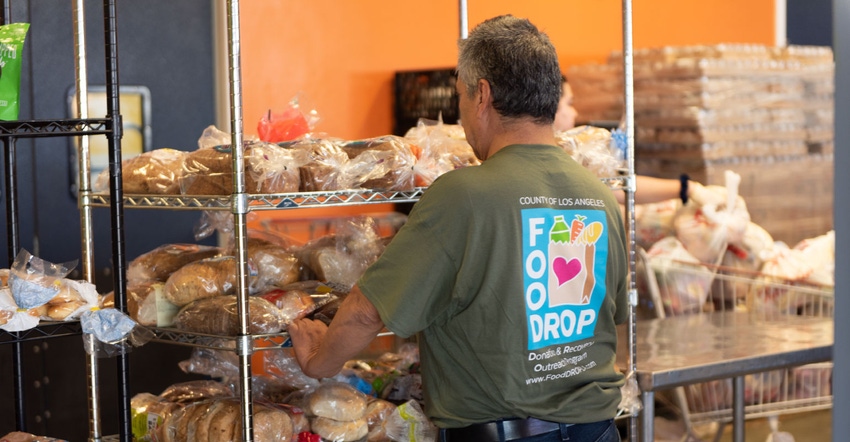Los Angeles County Public Works’ Food DROP Addresses Waste and Hunger

In Los Angeles County, 2.5 billion pounds of food — the equivalent of 2 billion meals — is thrown away annually, while one in seven residents are food insecure.
Those jolting figures are why LA County launched the Food Donation, Recovery and Outreach Program — Food DROP — with the county’s Public Works Department as the lead agency. Through this initiative, in partnership with the county’s health department and other local government entities, the Public Works department is raising awareness of food insecurity, working to reduce food waste, and helping local businesses join the effort.
At its basic level, Food DROP matches food-generating businesses with local food rescue agencies to funnel excess food to those in need rather than sending it to landfills. But while the need is clearly there — both for nonprofits who distribute food and businesses wanting a place for their excess — there is no simple solution. Finding ways for these entities to work together for a smooth handoff has taken a great deal of work.

To help make that happen, part of the Food DROP program includes free assistance to food-generating businesses.
Each business is matched with as many as three nonprofits, thus ensuring that there will almost always be a charity available to take the excess food. Food DROP coordinators further support the businesses through the challenges of salvaging and quickly moving volumes of good edibles.
“Businesses get discouraged if a pantry can’t take theie food, so we follow up to keep track of what kind of food they have and how much, in order to provide the best match,” says Jennifer King, Los Angeles County Public Works program manager. “And if business can’t transport the food, Public Works finds nonprofits that can pick it up quickly. Our program helps with challenges such as if nonprofits reject certain foods or if there are quantity issues. Sometimes businesses have a lot to donate at once, and sometimes minimal.”
Support begins even before the first donation is made, King says.
“We start with a consultation, which includes a waste audit,” she says. “We assess businesses’ purchase practices and recycling programs and determine what can be donated, and give a list of charities to donate edible excess to.”
The Public Works department also launched a website that has a list of nonprofit partners with contact information, an interactive map to locate nonprofits, food donation guidelines, and an online tool that businesses use to track how much they donate.

For now the focus is on large food waste generators, since California’s Senate Bill 1383 requires that generators recover edible food with a goal of recovering 20% by 2025.
“The program is a win-win,” says King. “Not only is edible food diverted and going to those in need, but we help businesses comply with the bill.”
When Food DROP launched in 2018, Public Works personnel visited food waste-generating businesses and made a few discoveries that helped shape their system. One thing they learned is that some generators had nonperishables while others had fresh foods. This is an important point, since not all nonprofits can distribute food fast enough to deal with perishables. So finding the closest possible nonprofits and those that could move food quickly became important.
To further facilitate the best partnerships, program coordinators identified nonprofits needing large quantities and matched them mostly with food distributors and supermarkets. They identified smaller charities and connected them with restaurants that may have some prepared, unserved leftovers at the end of the day. These smaller quantities typically end up in the hands of nonprofit partners that pass out food to homeless people on the street and to soup kitchens.
Over a dozen Tawa 99 Ranch Market stores across three states donate the equivalent of hundreds of meals a month through Food DROP.
“Our local food bank and food bank agencies work with our stores to set up the donation schedule based on mutual requirements, usually twice a week,” says Ruoqi Liao, assistant manager of Marketing and Promotion at Tawa. “The stores collect and categorize food, and the food bank picks it up.”
Communication is the key to making the process work. The food bank team representative and Tawa headquarters work closely together to ensure that the donation pickup process goes smoothly, Liao says.
“We firmly believe that food donation is an important practice of corporate social responsibility,” he says. “We trust all of our partners in the Food DROP program to effectively redistribute the donated food to our communities.”
As Food DROP coordinators help businesses with their needs, they work with nonprofits as well, providing food safety information from the public health department, for example. And lately, they have been supporting nonprofits through COVID-19.
“During this challenging time, we talk to nonprofit partners weekly and also pass resources to them, including grant and funding information for food recovery work,” King says. “Sometimes they can’t maintain operations at the level they had before, as there has been an increase in clients beyond what they can handle. So we refer them to other agencies that may be able to distribute food.”
Interfaith Food Center, which serves almost 3,000 people weekly, has lately experienced a drop in the quantity and quality of the food it rescues. This trend has meant a greater need for donations and business community partners, says Veronica Castro, the food center’s executive director.
Food DROP has helped fill some of the void, and the education piece has been especially instrumental.
“It’s essential to educate the business community on the amount of waste, the magnitude of food insecurity, food safety guidelines, mandatory recycling laws, and the Good Samaritan Act,” Castro says. “LA County Public Works and the Department of Public Health work together as great advocates and are connecting nonprofits to business partners to meet needs. We are grateful for the donations and the support from Food DROP and look forward to a long-lasting relationship to help support the community.”
Moving forward, the LA County Public Works Department is looking for ways to improve food collection methods and plans to establish a network with other jurisdictions to share information and to help them access resources to set up programs of their own.
The agency is also working with the county Department of Public Health to consider technology such as mobile apps to track and coordinate the transportation of food to further facilitate donations.
“The county and Public Works have a goal to divert 95% of waste by 2045, and organics are a big portion of what we receive, so we are proud of the Food DROP program,” says Coby Skye, assistant deputy director of environmental programs for the Public Works department. “We divert organics from landfills and reduce greenhouse gas emissions, and we address food insecurity. We get all of these benefits layered on top of each other. That makes this a fantastic program.”
About the Author(s)
You May Also Like




